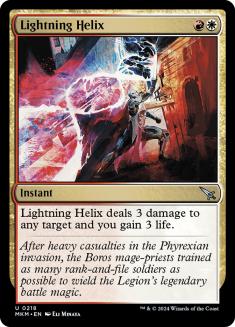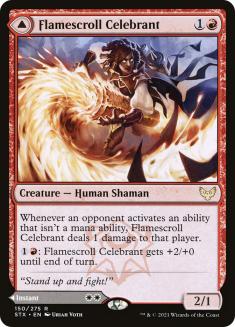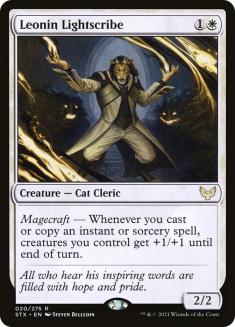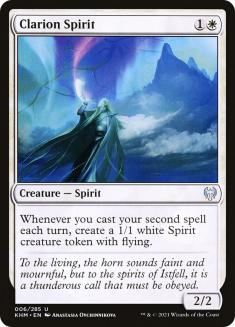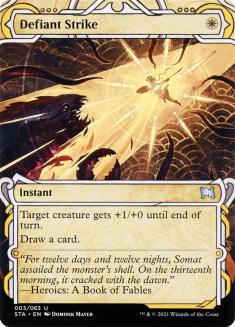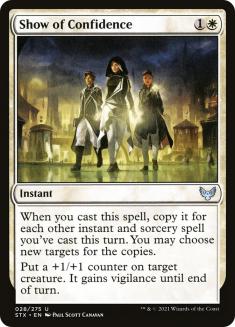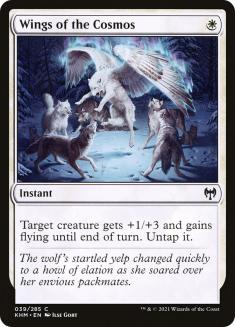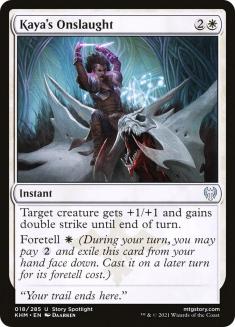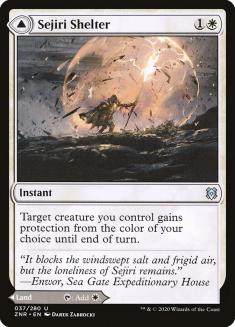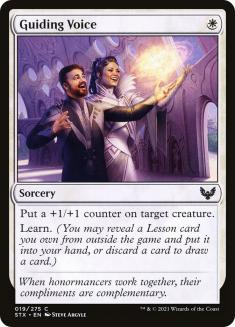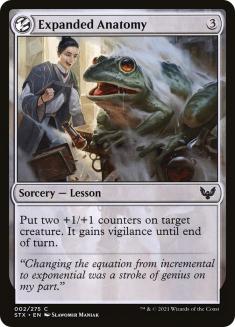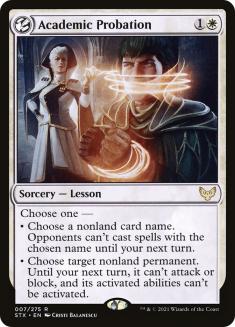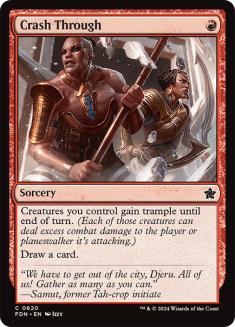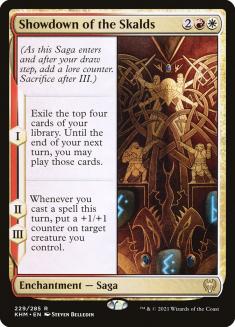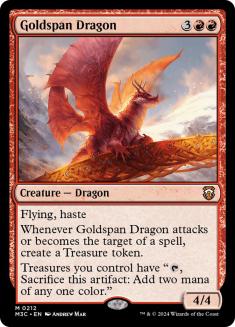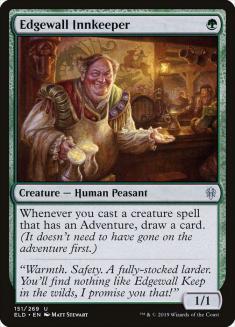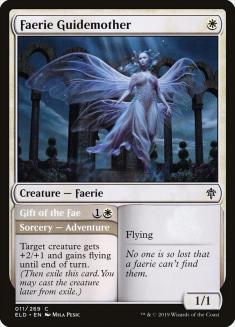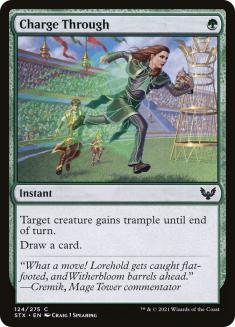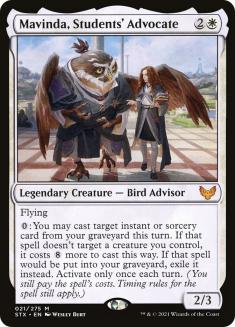Earlier this month, Dom Harvey wrote an article about the application of Clever Lumimancer in the older formats — Pioneer, Modern and even Legacy. In this week’s article, I want to talk about the applications of the card in the newer formats — Standard and Pioneer.
At first glance, Clever Lumimancer looks like it would definitely be more powerful in high-powered formats — after all, it thrives when you have multiple cheap spells to cast, and the older we go, the better the cheap spells are. However, it seems to me like there’s enough support in both Arena formats that we would be remiss if we didn’t at least try to make it work. Having played with the card in several different decks, I think the right shell is definitely there.
Historic
In Historic, the application is somewhat obvious — Boros Burn. All the Mono-Red Burn decks want to do is cast a creature on Turns 1 and 2 and then cast burn spells. Clever Lumimancer is perfect for this strategy, as this is exactly what it wants you to do as well. If you cast one spell, Clever Lumimancer attacks for the same as Soul-Scar Mage, but it scales better with each additional spell in the same turn, and this deck is definitely constructed in a way where you want to cast multiple spells in the same turn.
This is helped by the fact that the Boros mana in Historic is actually quite good. Sacred Foundry, Inspiring Vantage, and Needleverge Pathway are twelve relatively free white sources (though playing a Pathway on white on Turn 1 can be rough in land-light hands), and then you even have Furycalm Snarl and Clifftop Retreat as additional multicolored lands if you want. This means that the only real reason to not play Boros is if you’re super-interested in Faceless Haven, which is a card I want in Historic but not enough to give up Clever Lumimancer.
This is my current list:
Creatures (16)
Lands (21)
Spells (23)

On top of Clever Lumimancer, this deck also utilizes what is in my opinion one of the best Mystical Archive cards — Lightning Helix. The burn spell has competed with Lightning Bolt in other formats (though Lightning Bolt usually ends up winning), and it’s extremely strong at swinging any kind of race, more than offsetting the life you lose to play an untapped Sacred Foundry. In some matchups it’s not going to be relevant, but then neither is the Sacred Foundry damage, and its usefulness can actually surprise you. For example, I’ve seen Emergent Ultimatum combo piles that are geared towards dealing exactly twenty damage with two Scholar of the Lost Trove and an extra turn, and if that’s what they end up at, you could swing the game by having access to a lifegain spell. Maybe on its own Lightning Helix would not be enough to justify the white splash (though honestly it just might), but alongside Clever Lumimancer it’s a no-brainer for me.
On top of all that, you also have access to one of the best sideboard cards in Historic — Rest in Peace. With the release of Faithless Looting, dedicated graveyard strategies had a massive boom in popularity, and what all of these strategies have in common is that they’re cold to Rest in Peace if they can’t remove it. Sometimes they can remove it (Rip Apart, for example, is a good answer), but Izzet Phoenix decks for example are unable to deal with it. When you’re playing an aggressive deck, Rest in Peace is the exact type of bullet that you want in your sideboard, as you don’t need the versatile answers that control decks are looking for.
The biggest point of contention to me is whether to play Lurrus of the Dream-Den or not. Lurrus is obviously a very good card, especially with Ghitu Lavarunner and Viashino Pyromancer, because it means you can get an effect immediately when you cast it. On the other hand, Bonecrusher Giant is also a very good card that you have to give up playing. Right now my deck is playing two copies of Lightning Strike, and I think these would be better off as Bonecrusher Giants — I think the added utility of being a good 4/3 creature is worth more than the extra damage unless you’re specifically trying to kill three-toughness creatures. I also think the deck might be interested in Showdown of the Skalds, Experimental Frenzy, or Rampaging Ferocidon in the sideboard and playing Lurrus precludes playing all of those.
Right now, I’ve settled for Lurrus in Game 1 and Experimental Frenzy Game 2 against decks with a lot of removal spells, but it’s not clear to me that this is the right approach.
Another interesting sideboard card is Flamescroll Celebrant.
Aggressive decks like powerful sideboard cards, but I also feel that you can’t be too reactive — you couldn’t play, for example, a lot of Rest in Peace and Deafening Silence against Five-Color Emergent Ultimatum. Revel in Silence offers a powerful answer to Emergent Ultimatum while also just being a two-mana creature that you can attack with.
In Historic, I think the best Clever Lumimancer deck is almost unequivocally Boros. The combination of playing the cheap spells and wanting the aggression are going to make it hard to justify a different color combination. In Standard, however, there are more possibilities.
Standard
In Standard, most Clever Lumimancer decks are also going to want to include Leonin Lightscribe, and as a consequence you’re probably interested in more of a “go-wide” approach than the Burn decks from Historic. Here are some options of cards that pair well with it in Standard:
One card that goes very well with this approach is Clarion Spirit. You’re very interested in making flying tokens (which you can then pump with Leonin Lightscribe), and you’re also naturally playing a lot of cheap spells, some of which are going to cantrip. You don’t have to play Clarion Spirit in your Standard magecraft decks, but I assume most versions will.
The only cheap white cantrip in the format. You don’t really care about the +1/+0 — you’re just interested in the worse Opt.
Our version of “Storm,” this card will trigger magecraft several times for surprise bursts of damage. It does require some quick math during your combo turns, but it should not be too hard to figure out once you can “compartmentalize” where the damage comes from.
- Turn 1: Clever Lumimancer
- Turn 2: Leonin Lightscribe
- Turn 3: Defiant Strike + Show of Confidence
The first step is figuring out how much each magecraft trigger does for you. In this scenario, it translates into +4 damage (two from Leonin, two from Lumimancer). That’s going to result in 2 (Leonin’s power) + 1 (Defiant Strike) + 4 (both magecraft triggers) for the Defiant Strike. Then, for Show of Confidence, it’s 1 + 4 (itself + the four magecraft triggers) x 2 (since it’s happening twice). So the total amount of damage is seventeen. If you have another creature or another spell, it’s trivial to deal more than twenty damage, but seveteen can also actually work if they played an untapped DFC land. For example, someone could go Turn 2 Shatterskull Smashing + Brushfire Elemental, attack, and then just die on the way back. This is very fast!
This is the cheapest way to push through in white (there are other ways in other colors). As far as combat tricks go it’s not a great one, but it does make any creature basically immune to damage for a turn and it gets the job done by being very cheap.
This requires some set up to be cheap, but it’s definitely worth the trouble, as double-striking a Clever Lumimancer is no joke.
The other white way to push through damage. It’s not cheap and doesn’t give any power, but given that it occupies a land slot, we’re very likely to be interested in this.
I have mixed feelings on Guiding Voice, but this could be because originally I didn’t realize it was a sorcery so I just chump-attacked with my entire battlefield in one of my games and I still haven’t forgiven it for that. Being a one-mana spell is pretty good, but being a sorcery is pretty bad when your tricks tend to be multiplied.
Learn can be very powerful here, especially if you’re mono-white and don’t have that much in the way of a sideboard. The best targets are Expanded Anatomy and Academic Probation (Probation in particular is very good as another way to push through damage that triggers magecraft twice for only three mana). If you go Guiding Voice + Academic Probation + Show of Confidence, that’s five magecraft triggers and a blocker removed with only two cards.
I’ve also liked Environmental Sciences. I assumed I wouldn’t be interested in finding a land, but the fact that it counts as a spell is very appealing for magecraft.
So, what are we working with in Mono-White?
Originally I had Snow-Covered Plains and a couple of Faceless Havens, but the colorless source was actually a big liability in enough games that I just cut it for now (I frequently wanted to cast two or three cards in the same turn and couldn’t because I had a Faceless Haven or two on the battlefield). It’s possible the correct number of Faceless Havens is one or two, but I doubt it’s right to play four in this version.
Past that, we can also find some good options in other colors.
Crash Through is excellent in a deck like this because it’s a cantrip that also pushes through damage. Your creatures become so big that trample is often better than flying anyway, and the fact that this one isn’t instant is not that relevant as you don’t have to choose a target for it, so you don’t need to use it as a combat trick.
Showdown of the Skalds is very good at finding card quantity, and this deck is interested in boosting its creatures, since it has ways of pushing them through and ways of maximizing the boost (e.g. double strike). It does make you give up on Lurrus, but if you do that, then you gain access to some other powerful cards like Bonecrusher Giant.
Goldspan Dragon isn’t necessarily a combo with the magecraft creatures (though it can be, to some extent), but the key here is that they both want the same type of card in your deck. Giving Clever Lumimancer double strike is good, and giving Goldspan Dragon double strike is also good. Unleash Fury also can work very well with both, and Sejiri Shelter and Kazuul’s Fury fill the role of pushing damage through with either creature.
Another card that works well with Goldspan Dragon is Show of Confidence, first because you can cast a lot of spells in the same turn due to the Dragon, and second because each instance of it targets the Dragon again, basically giving you infinite mana. If you attack and cast Defiant Strike, Unleash Fury, and Show of Confidence, you’re going to end up with six mana on your main phase (plus the leftover mana from Defiant Strike in combat).
The downside of an approach like this is that you’re probably going to end up running fewer creatures, which means some hands will be more awkward (like all-pump hands) and Leonin Lightscribe is not going to be as good. However, the deck is extremely explosive and you will kill a lot of people out of nowhere with it.
I think there are two ways to build a Boros Magecraft deck — with and without Goldspan Dragon.
Creatures (16)
Lands (19)
Spells (25)

I think this deck might be a little light on cheap creatures, but I’m not sure Clarion Spirit is really what you’re looking for alongside Goldspan Dragon. The Spirit wants you to just cast your spells and the Dragon wants you to hold everything (the main way you win the game is just one big attack). It’s actually very unfortunate that Barge In doesn’t give the Lumimancer trample — since that’s a priority target, we’re forced to play Run Amok.
If we go without Goldspan Dragon, we become more of a “little creatures” deck.
Creatures (15)
Lands (19)
Spells (26)

This is more similar to the Mono-White version, but with more ways of pushing through damage.
Our last option is adding green, mostly for Edgewall Innkeeper.
This type of deck definitely benefits from playing Adventure cards, since they’re creatures that can trigger magecraft, and if we play Edgewall Innkeeper we can afford to play things like Faerie Guidemother, which are almost good enough to make the cut in other versions anyway.
We also have access to Charge Through, which is worse than Crash Through for the most part but can still be good enough. The presence of another targeted cantrip (as well as potentially fight spells) also facilitates playing another card — Mavinda, Students’ Advocate.
Mavinda, Students’ Advocate is basically the new version of Feather, the Redeemed, and I’ve loved playing with that card. Mavinda is worse at winning the game by itself, since you can only cast each spell one extra time, but it does have some benefits over Feather that aren’t just being easier to cast. One instance is when you draw the card late in the game and you no longer have the targeted spells. In this spot Feather does nothing, but Mavinda can rebuy any card you cast at any point. Given that you’re often incentivized to cast cheap spells early, removing this tension is very important.
Another potential upside for Mavinda is that it enables casting the same spell twice in one turn. If I have Feather and Defiant Strike, I can cast one Defiant Strike now and one next turn; with Mavinda, I can just cast two Defiant Strikes now. This can be important for explosive magecraft turns.
This is my current Selesnya list:
Creatures (28)
- 4 Lovestruck Beast
- 3 Faerie Guidemother
- 3 Giant Killer
- 4 Edgewall Innkeeper
- 4 Clarion Spirit
- 4 Clever Lumimancer
- 4 Leonin Lightscribe
- 2 Mavinda, Students' Advocate
Lands (20)
Spells (12)

This is the list I’m most on the fence about, because there are a lot more cards I wanted to play. Toski, Bearer of Secrets and Primal Might have both been very good and could easily find a spot in the maindeck, as well as the third and fourth copies of some of the cards in the deck. This is what I’m playing at the moment but the right numbers might end up being very different.
I think it’s possible to play Orzhov or Azorius as well, but I’ve had much more success with Selesnya, Boros, and straight Mono-White. It’s possible I just haven’t stumbled across the right way to build the decks, though. Sedgemoor Witch and Mentor’s Guidance are both very appealing cards for the strategy, so there might be a home for them that I haven’t thought of.
Overall, I’m not sure which version of white-based magecraft aggro is best, but it seems to me like there are enough ways of building the decks and enough potential in the card combinations that I’m going to spend some more time figuring them out. If you’re interested in aggro decks, I definitely recommend you do the same.


